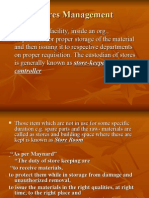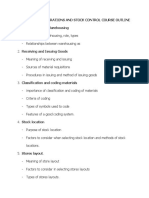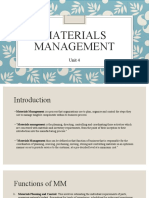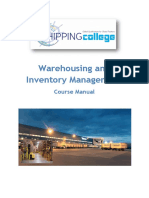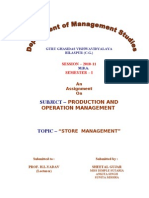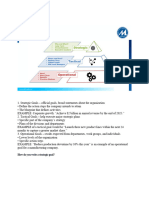Storage Function and Responsibilities
Uploaded by
WondmageneUrgessaStorage Function and Responsibilities
Uploaded by
WondmageneUrgessa2021
CHAPTER V - STORAGE
INTRODUCTION
Store keeping is a function of receiving, storing and issuing of materials. In almost all industries,
the materials represent a very large investment. It is therefore, important that strict orderliness
and method are employed to ensure accuracy, preservation, and safety at all stages of materials
movement and custody.
Meaning of store;
Store is the space, room, and the building where various types of materials, semi-finished goods,
and items purchased and manufactured in the organization are kept temporarily till they are
removed to supply for production and sales or used for consumption.
5.1. Storage Function and Responsibilities
1) receive all incoming materials and see that the quantities are correct according to
challan/invoice.
2) see that the Daily Goods Receipt is properly maintained
3) arrange for inspection of the material received
4) ensure that Goods Inward Notes are raised and distributed without delay
5) see that materials are properly stored against deterioration, theft, etc,… and that they
are readily available for use
6) issue materials against authorized requisitions to production and other departments
7) maintain accurate records of materials received, issued and in storage.
8) carry out stock verification in accordance with the procedure laid down by the
management
9) ensure that all documents relating to receipts and issues are sent to Stock Control,
Accounting and other departments without delay.
5.2. Location and Layout
All materials shall be stocked in a systematic way so that minimum time is spent in picking out
the materials for day-to-day issues. Thus, each rack and bin in the Stores will be identified with
a location number, which shall be indicated on the respective stock cards/Bin cards.
When dealing with the stores layout, there are two basic aspects to be considered. One is the
layout of storage areas or store-rooms and the other is the layout of bins and ranks in each store.
Instructors: Wondmagegn Urgessa Page 1
Material in the store room is money of the organization, there for it should be managed properly !!
2021
I. Layout of storage area
The following factors should be considered when stockroom layout is being planned:
Commodity factors – the characteristics of the items to be stored.
Activity factors – the activities that must be accommodated.
1. Commodity Factors
a. Nature of the Material
Items subject to deterioration need to be properly protected from extremes oftemperature,
dampness, rodents, insect infestation, and the like. Securityitems should be stored in vaults,
safes, or caged areas; sensitive items mustbe properly safeguarded. Hazardous commodities
including ammunition,flammable material, and oxidizing items need to be segregated from
eachother and from other types of supplies and stored in appropriate containersas applicable
according to Occupational Safety and Health Administration(OSHA) standards and require the
proper Material Safety Data Sheet(MSDS) to be on file.
b. Size, Weight, and Shape
Extremes of size, weight, or shape need to be considered. Large awkward containers and
unusually heavy items must generally be stored near shipping doors. Light and fragile items
should not be stacked to a height that would cause crushing or other damage to the containers
and their contents.
c. Turnover
Fast-moving items must be stored in readily accessible areas, where they can be handled quickly
and efficiently. Slow-moving items must be stored in less accessible or less desirable areas,
where structural conditions make stacking or handling operations difficult. In supply rooms with
issue counters, items issued most frequently should be located as close to the counter as possible.
The decision as to where to place items is called positioning.
d. Quantity
Large quantities of uniform packages are conducive to simple layouts. In contrast, small
quantities of various-sized items require special storage planning: small lots must be stored in
short rows, racks, or bins to provide proper segregation of supplies, maximum utilization of
space, and accessibility for issue.
Instructors: Wondmagegn Urgessa Page 2
Material in the store room is money of the organization, there for it should be managed properly !!
2021
2. Activity Factors
When stockroom or warehouse layout is planned, the activities that the space must accommodate
need to be considered. Those activities include storing, receiving, picking, packing, shipping,
over-the-counter issuing and handling of material, maintaining equipment, filing records, and so
on. In a space in which ceiling height varies, areas with lower ceilings must be used for receiving
and issuing, whereas areas with higher ceilings must be used for actually storing supplies.
II. Layout of bins and ranks
A uniform rule cannot be applied to the layout of bins and ranks. It will vary from store to store
and should take in to account the following;
- The size and shape of the stores and the position of the main entrance door,
- Kind of material to be stored,
- The type of bins and ranks proposed to be used
- The type of material- handling equipment proposed to be used
- Convenience for taking materials in and out of the bin
- Maximum utilization of floor and overhead space etc…..
5.3. Storage system and procedure
Storage Systems
The two main storage systems are; Centralized and Decentralized Stores.
In small privatizations, one store will be sufficient to store all the materials which can be
supplied by this centralized place to the other places or requirements. But, in large industrial
organization since the production shop floors or workshops are lying at different place and
sometimes located far away. So, the decentralization of stores is necessary in such organizations.
Advantages of centralized store
1. The Varity of goods can be supplied to all users from one small locations
2. Minimum inventory will be there as store will have limited capacity specially the tools,
fixtures, large parts and spare parts.
3. Less manpower will be required
4. Better control of materials is possible
5. Materials located in small available space ensures economy in storage
Instructors: Wondmagegn Urgessa Page 3
Material in the store room is money of the organization, there for it should be managed properly !!
2021
6. Receipt and inspection of materials can be efficiently organized
7. Materials handling will be easy
Disadvantage of centralized storing
- It may not be suitable for large manufacturing concerns
- More staff will be required for shifting and transportation of the materials to various
production unit
- Wastage and shortage of materials may be there
- Safety and maintenance of large amount of materials is difficult in large stores
- Record keeping is difficult
Note:-the disadvantages of centralized storing are advantage of decentralized storing and vise-versa.
Decentralized storing needs efficient planning of materials as well as location of storing them.
However, it is the convenience of the organization to select any one type of storing system. But,
the type of materials like small parts as nut, bolts, screw, fixtures, chemicals, paints, etc… have
to be stored at separate places, whose requirements may be at many place. The type of store will
be definitely depends up on the type of materials stored. Such as;
i. Consumable materials
ii. Raw materials entering the production
iii. Chemicals, acids etc…
iv. Inflammable and toxic materials like kerosene, petrol, diesel, lubricants,
flammable liquid and gases
v. Small parts like nut, bolts, screws, nails, fixture
vi. Hand tools and tools used for cutting machine
vii. Machinery and equipments
viii. Furniture
ix. Office materials and stationery etc.
5.4. Stoke Receipt, Issue and Dispatch
Stoke Receipt
The Receiving section is a central place where all incoming supplies are received, checked, and
inspected before storage or use. It also called Goods Inward Section. The functionssection are:
Instructors: Wondmagegn Urgessa Page 4
Material in the store room is money of the organization, there for it should be managed properly !!
2021
o Receive income materials
o Check materials received
o Arrange for inspection
o Raise Goods inward Notes (GIN)
o Inform purchase section regarding excess of supply, shortage or defective supply
o Deliver materials to the appropriate stores for storage.
Types of receiving section
The receiving section is of three types:
1. Centralized Receipt:- in organization having centralized types of receiving section, all
materials are first received there, checked, inspected and distributed to various stores
along with the goods inward notes.
2. Semi-centralized Receipt :- in organization having semi-centralized receipts, the records
are centralized and only light materials received in receiving section. Heavy materials are
received and checked at the respective stores. The objective is to save the work of
transporting heavy materials from receiving section to respective stores.
3. Decentralized Receipt :-in organization having decentralized receipts, a receiving section
is attached to each store.
Stock Issue
The “issue” function of stores management is the process of reacting to demands of the user for
goods held within the store. The success of these functions is often taken as a measure of the
efficiency of the whole stores operation.
Requisition:- a requisition is a written authority for the stores to issue materials to any person or
department of the organization entitled to draw materials from the stores. No issue shall be made
from the store without a proper requisition.
Issue procedures
There is a definite series of events that occur between the original need for a particular item of
stock and its final issue to the requisitioner.
Instructors: Wondmagegn Urgessa Page 5
Material in the store room is money of the organization, there for it should be managed properly !!
2021
1. Need determination( by user):-The user has to decide what the needs and the types,
quality specification and amount involved
2. Completion of Issue Note.:-The issue document has to be properly completed, giving fullest
possible details of the goods required.
3. Authorization(approval):- the requisitioner must locate the appropriate member of staff
designed to authorize issues from stock and seek his approval and signature. The person
designed to authorize the given issue of stock will be obligated to study very carefully the
type and details of the issue to ensure that demands are “real” and that the limits imposed
by the organization are kept.
4. Presentation to stores:- once the issue note has been checked and authorized it will be
presented to the store for delivery. A store is obligated to check all the data contained and
verify the reliability of the authorization given.
5. Identification :-store will then identify the items usually by the code number or reference
by which the item has been classified.
6. Selection:-once the item required has been identified: it can be selected from the store.
The method of selection employed will depend up on the form of stores organization and
the type of goods required.
7. Issue of stock requisitioner:- once the item has been selected, delivery or collection of
materials can be takes place.
8. Cost Allocation:- every item used in the running of the operation has to be cosseted
against a certain batch of production or against a departments budget to ensure that
costing department will be able to the true cost of production.
9. Notification of stock records and stock control :- it is very important that once materials
have been issued, both stock records and record cards are updated and that an accurate
picture of the total stock situation can be maintained.
Preservation of Materials And Protection Of Stores
The various types of materials stored will be affected by atmosphere and environment. These
types of materials must be preserved by keeping them in proper environment which will not
affect them. Some of the important protection methods necessary in every store are as follows:
Instructors: Wondmagegn Urgessa Page 6
Material in the store room is money of the organization, there for it should be managed properly !!
2021
1. Protection of store against fire: The stores must be located in fire-proof rooms. The
firefighting equipment like fire distinguishers, water and chemical sprinklers and inert gases are
used against fire. The fire alarms and other safety devices should be used in the stores against
fire. While doing welding in the store, precautions must be taken so that it will not be the cause
of fire or burning any other material.
2. Dust protection: Closed and dust-free enclosures should be used in the stores. Cleaning and
good housekeeping is necessary in the stores. Air conditioners prevent dust to enter in the stores.
Wherever ventilation is necessary specific type of ventilators are used so that dust should not
enter in the storerooms.
3. Maintaining proper environment: Proper air conditioning in the storerooms avoids
dampness. Dehumidifier maintains dryness in the stores. When the materials are kept outside, in
the store yards and sheds they must be protected against excessive exposure to light, heat and
rains by building proper type of sheds.
4. Protection against corrosion: Those materials which are corroded by atmospheric moisture
should be protected against corrosion by painting, coating or greasing by anti corrosive
chemicals particularly machine parts, bearings and gears etc.
5. Fast-deteriorating materials should be used immediately and their storage should be limited.
Overstocking of deteriorating materials should be avoided. Proper type of containers and storage
places are necessary to keep deteriorating items. Their expiry time is to be mentioned on these
containers. These items should be handled carefully.
6. Prevention of theft is very necessary in every stores department. Un-authorized persons should
be prevented from entering in to the stores. The guards should check all the persons going out of
the stores. The stores are assets of the company. The use of proper preservation methods and
protection of stores avoids lot of wastages of materials and goods. While planning the stores
layout and location one of the important criteria is preservation of inventory and protection of all
types of materials against atmosphere.
5.5. Stock Taking and Stock Verification
Store verification means, testing or checking the stores record with the actual items stoked in the
store. The store record at any time should show the exact physical quantity of raw materials and
parts which are available for use. Store verification also referred as to stock taking is meant to
Instructors: Wondmagegn Urgessa Page 7
Material in the store room is money of the organization, there for it should be managed properly !!
2021
ascertain any discrepancy of actual store when comparing with record.Store verification or
stocktaking is also sometimes called internal audit of store. Discrepancy revealed by physical
verification may be one of the two types:
1. Store materials (stores) short of what the record shows
2. They are in excess of what the record shows
Store verification revels if there is any discrepancy of stored materials with the stores record;
discrepancy may arise due to:
Clerical error
Wrong description
Incorrect counting
Omission in issue of material
Omission in recording issued material
Loss due to damage, breakage or deterioration and Small thefts ….etc
VERIFICATION OF MATERIALS
A. Periodic Counting the Items
The inventory will be verified by counting each item kept in the store once or twice in a year by
a person other than those who are working in the stores department or the team whom the
verification work is assigned.
While inexpensive items may be checked once a year, expensive and attractive items should be
checked three or four times a year. The physical balance obtained at the end of the financial year
will form the inventory for final accounts.Before verification, the stores persons should keep
their records up to date.
B. Continuous / perpetual Counting Method
In this method, the inventories are counted continuously throughout the year physically to keep
the regular records of all the items and materials. This checking work will be assigned to a team
of persons who will continuously verify the stores items. They are properly trained for that. This
method though avoids discrepancies and errors in materials storage, but delays in normal work of
material receipt and issue. Many a time it may not be possible to continue the continuous
checking of the materials throughout the year.
C. Spot Checks
Instructors: Wondmagegn Urgessa Page 8
Material in the store room is money of the organization, there for it should be managed properly !!
2021
Spot checks are made by the store keeper at the time of receiving first stock or while issuing
store items. This method is voluntarily carried out by the stores’ staff for their own satisfaction
and for accuracy of store materials. Moreover, it is not a regular method of verification and there
is no set method of doing it.
This method also does not get any official recognition because it does not provide any
information to management regarding to storages excess etc. This is certainly over and above the
normal methods of stores verification being used by the store house. This method of stock
verification is generally adopted in all those organizations where a continuous system of stock
verification is not functioning.
D. Stock out / low point Verification
This method of stores verification is resorted to when a particular item of stock is out of stock.
Again, when the stock has touched the danger level or it has come down to a level where
replenishment may become an emergency, then also low point stores verification is done.
Generally, this type of verification is done by stores house staff. The store keeper maintains a
record of such verification. He is also obliged to report to the replenishment and’ or purchase
section including accounts department and his seniors about the result of such verification for
soliciting instructions and applying correction, if there is any need for the same.
E. Annual Stock Taking:
Where periodical stock taking by stores staff or continuous stock verification by accounts staff is
not in force, complete checking once a year is very desirable.
Annual stock taking is done in the last month of the financial year. In certain places, the factory
will be closed for a few days and in other places the receipts and issues will be suspended until
the stock taking is over.
Circulars are also sent in advance to the suppliers not to deliver any material during stock taking
days. Closing of the work, suspension of receipts and issues etc. might be possible in small
plants but would involve serious loss of production to a large organization.
Instructors: Wondmagegn Urgessa Page 9
Material in the store room is money of the organization, there for it should be managed properly !!
You might also like
- Darbour Group Hospitals Case Study and Action PlanNo ratings yetDarbour Group Hospitals Case Study and Action Plan18 pages
- Chapter Five Storage Management: The Objectives of Stores Can Be Classified As FollowsNo ratings yetChapter Five Storage Management: The Objectives of Stores Can Be Classified As Follows9 pages
- Seminar Topic (Location and Type of Stores)No ratings yetSeminar Topic (Location and Type of Stores)4 pages
- Department of Building Technology KnustNo ratings yetDepartment of Building Technology Knust37 pages
- Chapter 10 Material Management and LogisticsNo ratings yetChapter 10 Material Management and Logistics9 pages
- Warehousing and Inventory Management PDFNo ratings yetWarehousing and Inventory Management PDF99 pages
- Storage & Warehousing: BY: Prof. Maria Nieves D. ElarcoNo ratings yetStorage & Warehousing: BY: Prof. Maria Nieves D. Elarco19 pages
- Warehouse Management Final Project Report CompressNo ratings yetWarehouse Management Final Project Report Compress23 pages
- Warehousing Operations and Stock Control-GptNo ratings yetWarehousing Operations and Stock Control-Gpt40 pages
- ch5 Accounting For Cash and RecievablesNo ratings yetch5 Accounting For Cash and Recievables38 pages
- Inventory Control (Management) : 1. Raw Materials 2. ComponentsNo ratings yetInventory Control (Management) : 1. Raw Materials 2. Components21 pages
- WSU, CBE, MGT.: Chapter I - IntroductionNo ratings yetWSU, CBE, MGT.: Chapter I - Introduction7 pages
- 盖章ICPO QUANTUM PETROLEUM APRIL 2024 EN590No ratings yet盖章ICPO QUANTUM PETROLEUM APRIL 2024 EN5905 pages
- Nigerian Society of Engineer: Course Material OnNo ratings yetNigerian Society of Engineer: Course Material On29 pages
- The Role of Career Anchors in Human Resource Strategy Shahre Rey Branch Islamic Azad UniversityNo ratings yetThe Role of Career Anchors in Human Resource Strategy Shahre Rey Branch Islamic Azad University8 pages
- Ppap Check List: Lear Automotive India Pvt. Ltd.,Nasik100% (1)Ppap Check List: Lear Automotive India Pvt. Ltd.,Nasik73 pages
- 02968 RG Implementation Tool CSQM 1 Quality ManagementNo ratings yet02968 RG Implementation Tool CSQM 1 Quality Management93 pages
- Portfolio Optimization Project 2 FIN 653 Professor Natalia Gershun Group Members: Reynold D'silva Hanxiang Tang Wen GuoNo ratings yetPortfolio Optimization Project 2 FIN 653 Professor Natalia Gershun Group Members: Reynold D'silva Hanxiang Tang Wen Guo11 pages
- Event Management Services NC Iii: Prepared By: Kimberly E. AnilaoNo ratings yetEvent Management Services NC Iii: Prepared By: Kimberly E. Anilao8 pages
- Corporate Restructuring A Modern Alternative For A Companys SurvivalNo ratings yetCorporate Restructuring A Modern Alternative For A Companys Survival15 pages
- Founder S Pocket Guide To Market Size 1697915379No ratings yetFounder S Pocket Guide To Market Size 16979153791 page
- Darbour Group Hospitals Case Study and Action PlanDarbour Group Hospitals Case Study and Action Plan
- Chapter Five Storage Management: The Objectives of Stores Can Be Classified As FollowsChapter Five Storage Management: The Objectives of Stores Can Be Classified As Follows
- Storage & Warehousing: BY: Prof. Maria Nieves D. ElarcoStorage & Warehousing: BY: Prof. Maria Nieves D. Elarco
- Warehouse Management Final Project Report CompressWarehouse Management Final Project Report Compress
- Sub-Zero Structures: Cold Storage Design EvolutionFrom EverandSub-Zero Structures: Cold Storage Design Evolution
- Inventory Control (Management) : 1. Raw Materials 2. ComponentsInventory Control (Management) : 1. Raw Materials 2. Components
- The Role of Career Anchors in Human Resource Strategy Shahre Rey Branch Islamic Azad UniversityThe Role of Career Anchors in Human Resource Strategy Shahre Rey Branch Islamic Azad University
- Ppap Check List: Lear Automotive India Pvt. Ltd.,NasikPpap Check List: Lear Automotive India Pvt. Ltd.,Nasik
- 02968 RG Implementation Tool CSQM 1 Quality Management02968 RG Implementation Tool CSQM 1 Quality Management
- Portfolio Optimization Project 2 FIN 653 Professor Natalia Gershun Group Members: Reynold D'silva Hanxiang Tang Wen GuoPortfolio Optimization Project 2 FIN 653 Professor Natalia Gershun Group Members: Reynold D'silva Hanxiang Tang Wen Guo
- Event Management Services NC Iii: Prepared By: Kimberly E. AnilaoEvent Management Services NC Iii: Prepared By: Kimberly E. Anilao
- Corporate Restructuring A Modern Alternative For A Companys SurvivalCorporate Restructuring A Modern Alternative For A Companys Survival








